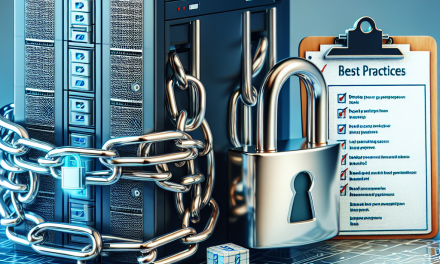Introduction
Windows Server Clusters are an essential component of many organizations’ IT infrastructures, providing high availability and scalability. However, as with any technology, they are vulnerable to security risks that can jeopardize services and sensitive data. In this article, we will explore best practices to enhance security in Windows Server Clusters, providing you with the tools necessary to safeguard your environment effectively.
Understanding Windows Server Clusters
Windows Server Clusters allow multiple servers to work together to provide redundancy and improve resource availability. They are widely used in environments that require uptime and continuity, such as databases, file sharing, and critical applications. However, the more connected and complex your infrastructure, the higher the risk of security threats.
Best Practices for Enhancing Security in Windows Server Clusters
1. Implement Strong Authentication Mechanisms
Implementing robust authentication measures is the first step towards securing your Windows Server Clusters. Consider integrating the following practices:
-
Use Active Directory: Rely on Active Directory for authentication. Ensure that only authorized users have access to cluster management interfaces.
- Multi-Factor Authentication (MFA): Whenever possible, enforce MFA for an additional layer of protection against unauthorized access.
2. Limit Role Access and Permissions
Principle of least privilege should be enforced in your Windows Server Clusters:
-
Restrict Access: Limit permissions to only those necessary for users to perform their job functions. This minimizes the risk of accidental or malicious changes.
- Using Role-Based Access Control (RBAC): Assign roles based on job functions to standardize access controls and simplify audits.
3. Keep Software Up to Date
Ensuring your systems are up to date is one of the most effective ways to combat vulnerabilities:
-
Regular Updates: Frequently apply Windows updates, hotfixes, and service packs to your servers and cluster management tools.
- Vulnerability Management: Conduct periodic vulnerability assessments to identify and address potential risks.
4. Network Security Measures
Implement robust network security configurations to protect your cluster communications:
-
Segregate Networks: Use Virtual Local Area Networks (VLANs) to segment cluster traffic from other network traffic, reducing the attack surface.
- Firewalls and Access Control Lists (ACLs): Configure firewalls and ACLs to limit traffic to the necessary ports and protocols, thereby protecting against unauthorized access.
5. Enable Data Encryption
Protecting data in transit and at rest should be a priority:
-
Use SMB Encryption: Enable Server Message Block (SMB) encryption to secure data transmitted between cluster nodes.
- Database Encryption: For database clusters, employ Transparent Data Encryption (TDE) for safeguarding sensitive data stored on disk.
6. Regular Backups and Disaster Recovery Plans
Backing up critical data is essential in case of a security breach:
-
Automate Backups: Schedule regular backups of your cluster configurations and associated data to ensure quick recovery in a disaster scenario.
- Test Your Recovery Plan: Regularly review and test your disaster recovery plan to ensure it can reliably restore operations when needed.
7. Monitoring and Logging
Continuous monitoring of your servers can help you identify potential threats early:
-
Enable Auditing: Activate server auditing to track user activity and changes made in the cluster environment.
- Use Performance Monitoring Tools: Deploy monitoring solutions to observe the health status of your cluster and identify any unusual behavior.
8. Educate and Train Employees
Human error is often the weakest link in security:
-
Regular Training: Conduct security awareness training for all users interacting with the cluster to educate them on safe practices.
- Incident Response Training: Prepare your team for security incidents by simulating scenarios and formulating response strategies.
Conclusion
Securing Windows Server Clusters requires a comprehensive approach that includes strong authentication, regular updates, strict access controls, and effective monitoring. By adopting these best practices, organizations can significantly enhance the security posture of their clustered environments, ensuring high availability while protecting sensitive data.
Regularly review and update your security policies to adapt to new threats. A proactive approach to security will safeguard your cluster—and ultimately, your organization—from the evolving landscape of cyber threats.
For more insights on Windows Server security and management practices, follow WafaTech Blogs and stay ahead of the game.
About WafaTech
WafaTech is dedicated to providing you with the latest insights and best practices in technology, security, and IT management. Our mission is to empower organizations to navigate the complexities of the IT landscape confidently. Join us in our journey to optimize your IT environments securely.





